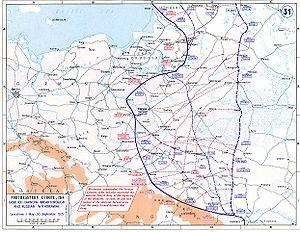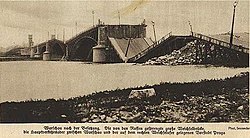Great Retreat (Russian)
This article includes a list of general references, but it remains largely unverified because it lacks sufficient corresponding inline citations. (May 2020) |
| Great Retreat | |||||||||
|---|---|---|---|---|---|---|---|---|---|
| Part of the Eastern Front of World War I | |||||||||
 Russian withdrawal in 1915. | |||||||||
| |||||||||
| Belligerents | |||||||||
|
|
| ||||||||
| Commanders and leaders | |||||||||
|
|
| ||||||||
| Strength | |||||||||
|
1,136,000 4,650 field guns in German sector[1] |
1,200,000 6,000 field guns 9,300 fortress guns[2][failed verification] | ||||||||
| Casualties and losses | |||||||||
|
430,800+ Germany: 447,739 casualties[3] Austria Hungary: Unknown, but in hundreds of thousands casualties[4] |
1,500,000+ at least 500,000 killed or missing 1,000,000 captured 9,300 fortress guns captured[5] | ||||||||
The Great Retreat was a strategic withdrawal on the Eastern Front of World War I in 1915. The Imperial Russian Army gave up the salient in Galicia and Poland. The Russians' critically under-equipped and (at the points of engagement) outnumbered forces suffered great losses in the Central Powers' July–September summer offensive operations, this leading to the Stavka ordering a withdrawal to shorten the front lines and avoid the potential encirclement of large Russian forces in the salient. While the withdrawal itself was relatively well conducted, it was a severe blow to Russian morale.
Background[]
Following the German success with their Gorlice–Tarnów offensive, Hans von Seeckt proposed that August von Mackensen's Eleventh Army should advance north towards Brest-Litovsk, with their flanks shielded by the rivers Vistula and Bug.[6] Mackensen and Erich von Falkenhayn supported this strategy of attacking the Russian salient in Poland, and forcing a decisive battle. Ober Ost, led by Paul von Hindenberg and Erich Ludendorff, would attack towards the southeast, while Mackensen turned north, and the Austro-Hungarian Second Army attacked east. The Ober Ost Twelfth Army, led by Max von Gallwitz, would advance to the northeast of Warsaw, while the Ninth Army, led by Prince Leopold of Bavaria, the Woyrsch Corps, led by Remus von Woyrsch, and the Austro-Hungarian First Army, led by Paul Puhallo von Brlog, pushed the Russians eastward to the Vistula. The Army of the Bug, led by Alexander von Linsingen, the Austro-Hungarian Second and Seventh Armies, led by Eduard von Böhm-Ermolli and Karl von Pflanzer-Baltin respectively, protected Mackensen's eastern flank. On Mackensen's western flank was the Austro-Hungarian Fourth Army, led by Archduke Joseph Ferdinand. [7]
On 24 June, the Russian Tsar Nicholas II met with his senior leaders in Baranovichi, where it was agreed to no longer defend the Polish salient. The new Russian line would run from Riga, Kovno, Grodno, Breast-Litovsk, along the upper Bug, and then along Dniester into Romania. The Third and Fourth Armies were also placed under the control of Mikhail Alekseyev's Northwest Front, consisting of the Second, First, Twelfth, Tenth and Fifth Armies, deployed south to north. Alekseyev then planned a slow withdrawal from the salient.[7]: 274–275
The Ober Ost attack was to commence on 13 July, followed by Mackensen's advance on 15 July. The strategic Russian railway center of Włodzimierz Wołyński was an early priority of Mackensen.[7]: 292
Offensive[]


During the first two days of battle, Gallwitz's Twelfth Army pushed Alexander Litvinov's First Army back 9 miles (14 km) and captured 7,000 prisoners. By 17 July, Gallwitz's Twelfth Army and Friedrich von Scholtz's Eighth Army had pushed the Russian First and Twelfth Armies to the Narew. On 14 July, the Austro-Hungarian First Army, redeployed from the south of Woyrsch Corps to the east of Mackensen, advanced towards Sokal. The First Army was then to form a bridgehead across the Bug, defended by the Russian Eighth Army, which they achieved by 18 July, and commenced to move towards Włodzimierz Wołyński. On 15 July, the Bug Army overran Russian defenses, forcing their retreat. On 16 July, Mackensen's Eleventh Army overran the first line of Russian defenses, captured Krasnostaw, and about 6000 prisoners. By 18 July, they had advanced north 19 miles (31 km), and captured 15,000 prisoners. On 17 July, the Woyrsch Corps commenced its attack, and captured Radom.[7]: 267, 293–296
On 22 July, as the Austro-Hungarian Fourth Army advanced towards Lublin, Alexeyev ordered a retreat towards Ivangorod. On 23 July, Ober Ost was able to establish a bridgehead across the Narew at Pułtusk. At this stage of the battle, a swift breakthrough by the Central Powers became doubtful. In the words of Ludendorff, "The Russian Army was certainly forced to move [back], but it escaped. It launched constant determined counterattacks with powerful forces to reorganize and successfully mount prolonged resistance." Max Hoffmann noted, "It seems that the Russians are actually repeating [the events of] 1812 and retreating along the entire front. They are setting fire to hundreds of their own villages, whose inhabitants have been evacuated."[7]: 298–301
As the Russian army retreated, the Chief of the General Staff Nikolai Yanushkevich, supported by Grand Duke Nicholas, ordered the army to devastate the border territories and expel the "enemy" nations within.[8][9] The Russian authorities deported 500,000 Jews and 250,000 Germans into the Russian interior.[9] On 11 June, a pogrom began against Germans in Petrograd, with over 500 factories, stores and offices looted and mob violence unleashed against Germans.[9] The Russian military leadership regarded Muslims, Germans and Poles as traitors and spies, while Jews were considered political unreliables.[8]
On 29 July, Woyrsch established a bridgehead across the Vistula north of Ivangorod, forcing the Russians to abandon the fortress there. On 31 July, Mackensen captured Lublin, and on 1 August, the Bug Army captured Khelme. Alexeyev then ordered Warsaw to be abandoned, and on 5 August, Prince Leopold's Ninth Army marched into the city. On 17 August, the German Tenth Army captured Kovno and the Kaunas Fortress. The Novogeorgievsk Fortress was encircled by the Germans on 10 August, and Hans Hartwig von Beseler's siege guns forced its surrender on 20 August. The Osowiec Fortress was also eventually abandoned by the Russians, followed by a German chlorine gas attack. Kovel was abandoned by the Russians on 21 August, and Stavka abandoned Baranovichi for Mogilev.[7]: 303–305, 306–318, 322–324
Mackensen's Eleventh Army, and Linsingen's Bug Army, continued their northerly advance towards Brest-Litovsk, occupying the citadel on 26 August. Otto von Below's Army of the Niemen advanced into southern Latvia, while Scholtz's Tenth Army advanced towards Vilna, which was abandoned by the Russians on 17 September.[7]: 320–323
Aftermath[]

According to Prit Buttar, "...as far as Falkenhayn was concerned, he had achieved all that he could expect to achieve on the Eastern Front. Russia was clearly not going to accept a separate peace, and the complete destruction of the Russian Army had never been his intention. With so much territory gained and so much damage done to the Russians, it was highly likely that there would be no threat from the east for the foreseeable future."[7]: 305, 322
The tsar assumed command of the military, dismissing Grand Duke Nikolai, and Nikolai Yanushkevich.[7]: 324–325
See also[]
References[]
- ^ Norman Stone, The Eastern Front, 1975, p.191
- ^ Norman Stone, The Eastern Front, 1975, p.174
- ^ Richard L. DiNardo, 2010, p. 132-133
- ^ Österreich-Ungarns letzter Krieg Band III, Wien 1932, S. 163
- ^ Norman Stone, The Eastern Front, 1975, p.191
- ^ DiNardo, 2010, pp. 106-107.
- ^ a b c d e f g h i Buttar, Prit (2017). Germany Ascendant, The Eastern Front 1915. Oxford: Osprey Publishing. pp. 265–274, 282, 285–286, 292, 295. ISBN 9781472819376.
- ^ a b Baberowski & Doering-Manteuffel 2009, pp. 202–203.
- ^ a b c McMeekin 2017, p. 68.
Bibliography[]
- Baberowski, Jörg; Doering-Manteuffel, Anselm (2009). Geyer, Michael; Fitzpatrick, Sheila (eds.). Beyond Totalitarianism: Stalinism and Nazism compared. Cambridge University Press. ISBN 978-0-521-89796-9.
- McMeekin, Sean (2017). The Russian Revolution: A New History. London: Basic Books. ISBN 978-0-46503-990-6.
Further reading[]
- Johnson, Douglas Wilson (1916). "The Great Russian Retreat". Geographical Review. American Geographical Society. 1 (2): 85–109. doi:10.2307/207761. JSTOR 207761.
- Norman Stone, The Eastern Front 1914-17 (London, 1975) pp. 165–193
- Stanley Washburn. Victory in defeat; the agony of Warsaw and the Russian retreat
- Stanley Washburn. The Russian campaign, April to August, 1915
- Conflicts in 1915
- Battles of the Eastern Front (World War I)
- Battles of World War I involving Germany
- Battles of World War I involving Russia
- 1915 in the Russian Empire
- July 1915 events
- August 1915 events
- September 1915 events
- Ukraine in World War I
- World War I crimes by the Russian Empire